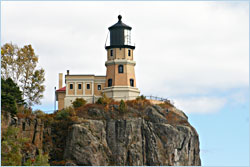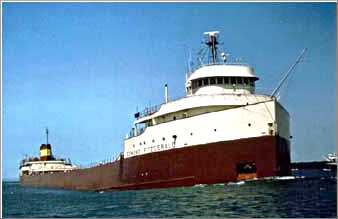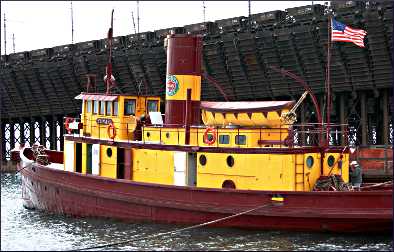Gales of November
Along the North Shore, early-winter winds evoke visions of shipwrecks.

© Beth Gauper
In November 1905, the people of Minnesota saw Lake Superior at its most malevolent.
As dozens of ships left Duluth-Superior Harbor in the calm after a violent storm, an even worse storm hit, with blinding snow and winds of more than 60 mph.
The 4,840-ton steel steamer Mataafa turned back and, just as it was about to slip into the harbor entry, was lifted by a giant wave, upended and smashed into first one concrete pierhead, then the other.
Another wave whirled the 430-foot boat around and grounded it 600 feet off the beach, where mountainous waves cleaved its stern from its bow.
Ten thousand Duluthians, many of whom had watched two other boats founder hours earlier, kept vigil by the light of bonfires as the storm blew. On the Mataafa, 15 crewmen kept warm by a fire built in the captain's bathtub.
They were rescued the next day, but nine were lost — including four men who had lashed themselves to masts and frozen.
"To watch these men die was really hard on the citizens of Duluth," said Scott Anfinson of the Minnesota Historic Preservation Office, who has documented Minnesota shipwrecks. "This made people aware of how dangerous the lake was."
The 1905 storm, which became known as the Mataafa Blow, damaged 29 ships on Lake Superior. The lake has been called the most dangerous body of water in the world, an inland teakettle in which any tempest can be deadly.
When a cold Canadian nor'wester hits the warmer lake, it can gather strength across 200 miles of open water and whip toward Michigan's Whitefish Bay with waves that, swirling around the narrowing lake, can twist a boat in two.
Winds that blow from the east have less time to build. But when they hit, they hit rock — and heaven help any boat caught in between.
"We all love the rugged beauty of the North Shore," Anfinson said. "But it doesn't have any beaches, which is unfortunate for any ship being dragged against it."
Few signs remain of North Shore shipwrecks, at least above the water — sport divers often visit the wrecks that remain, such as the Madeira, within sight of Split Rock, and the Samuel P. Ely, a schooner-barge that was driven into Two Harbors' Agate Bay in 1896.
But the stories are vivid even to those who look on from the shore. Late one October, three friends and I took a shipwreck tour of the North Shore, stopping first at the Lake Superior Maritime Visitor Center on Duluth's Canal Park.

© Torsten Muller
We found Thom Holden manning the desk and asked him to point out where the Mataafa foundered and also the site of the Thomas Wilson, a whaleboat rammed by a wooden steamer in 1902 and sunk not far from the canal entry, where oceangoing vessels often wait their turn at the grain docks.
But then, inevitably, we asked about the Edmund Fitzgerald.
The Fitzgerald, the fabled ore boat that vanished in a 1975 storm, is not a Minnesota wreck. It left from Wisconsin, after picking up taconite in Superior, and went down off the Michigan coast near the international border. Canada has jurisdiction over the wreck, and the captain and much of the crew were from Ohio.
But the Fitz was a familiar sight in the Twin Ports, as is the Arthur M. Anderson, whose radio correspondence with the Fitz provided the only clues to its disappearance.
The Fitzgerald is discussed in Duluth every year at the Gales of November conference, and every Nov. 10 at Split Rock Lighthouse, the beacon is lighted and the names of the 29 dead sailors read.
So we went over the various theories: The Fitz hit a shoal. It had design flaws. Its steel and welds were overstressed from years as a workhorse. It was hit by the Three Sisters — a Lake Superior phenomenon in which two rogue waves hit, followed by a third, massive wave that overwhelms the boat as it struggles to recover.
Holden's conclusion: All of the above.
"With all Lake Superior shipwrecks, it's a series of events," he said. "But with this one, it was series after series after series of things."
Does Holden ever get tired of speculating about the Fitz? "No, not really," he replied with a smile. "As you probably can tell."
Over his head, a video monitor announced that afternoon's arrival of the Arthur M. Anderson. We walked to the back of the museum and gazed at a model of the Fitz, torn, twisted and scattered on a bed of sand.
The dramatic stories made our next stop, Knife River, an anticlimax. Amid fog in June 1904, the captain of the Niagara ran his tug onto Knife Island, tricked by "compass devils," or minerals, that drew the compass needle eastward toward shore.
Just before the boat disintegrated in the pounding surf, the tug Edna G. rescued its 13 occupants.
Farther out, the Onoko lies upside-down, the victim of sudden hull failure in 1914; its crew rowed themselves to safety.
In Two Harbors, we stopped to see the Edna G., the St. Bernard of the North Shore. Retired in 1981 after 85 years of service, she was on the scene at hundreds of mishaps — but not on Oct. 29, 1896, when a gale blew the wooden schooner Ely into Agate Bay.
Its wreck now lies on the inside of the west breakwall, next to the ore docks.

© Beth Gauper
"It's seldom safe in this area," said Sheila Fallon, a Lake County Historical Society volunteer who was working at the Lighthouse B&B, in the red-brick 1891 building that's the last working lighthouse on the North Shore. "Last weekend, the weather changed six times in one day."
We walked up the beacon tower, then toured the pilothouse of the Frontenac, pushed onto a Silver Bay reef by a 1979 squall and eventually scrapped.
It was the same spot that in May 1905 claimed the Hesper, which was towing the Ely in the 1896 gale but escaped damage.
Heading up the shore, we passed through the Lafayette tunnel, named for the steel steamer that, in November 1905, was pulverized against the nearby cliff, now called Lafayette Bluff.
In the same storm, winds hurled the steamer Edenborn into the mouth of the Split Rock River and cracked it in the middle.
The Edenborn's steel barge, the Madeira, was not so fortunate. Just yards from a pebble cove, winds hammered the Madeira against the base of Gold Rock.
It was starting to break up when seaman Fred Benson jumped onto the sheer face of the cliff and scrambled to the top with a coil of rope.
Weighting it with a rock, he threw it back to the sinking boat, from which eight of the nine crewmen were able to climb to safety.
Today, Gold Rock is part of Split Rock State Park, and a path leads to the cove that separates it from the lighthouse. From there, we stared over at Gold Rock, whose face, covered with patches of orange lichen, flares outward as it rises from the water.
"How did that first guy get up?" Becky wondered. "Think of his hands — it'd be cold, there'd be ice. Now, that would make a movie."
From the cove, we followed a path through woods to the top of the rock, where I lay on my stomach and gingerly looked over the edge.
There, just to the right at the foot of the cliff, were the dark outlines of the Madeira, the base of its bow just 40 feet down and often visited by divers.
In the visitors center of the lighthouse, built in 1909 after intense lobbying by ship owners, we saw an underwater video of the wreck, and a film about the construction of he lighthouse.
"Instead of improving their underpowered and uninsured boats, the steel-company owners went to Washington and lobbied," a narrator playing Split Rock's builder says.

© Beth Gauper
It was not the beacon but the fog signals that proved most useful. The picturesque, pale-yellow lighthouse became indispensable to tourists, however, who flocked to it as soon as the North Shore highway was opened in 1924.
The beacon was turned off in 1969 but the tourists kept coming, making Split Rock the most-visited historic site in Minnesota despite its five-month season.
"They could've shut it down after World War II because of radar and other developments," says former site manager Lee Radzak, who lived in the middle keeper's house for many years. "They did keep it open a good 10 years after they needed to, it was such a showplace for the Coast Guard."
Today, it's the place to be for those who, on windswept days, want to imagine the gales of November.
Trip Tips: Shipwrecks and storm watching on Lake Superior
Storm-watching: Many lodgings offer specials in November; check web sites. NOAA's National Weather Service makes Lake Superior forecasts that help estimate what wave action will be during your stay.
The National Weather Service in Duluth lists nine of the biggest storms.
Podcasts: Listen to podcasts about Great Lakes shipwrecks.
Lake Superior Maritime Visitor Center in Duluth: Admission is free.
Shipping ends for the season when the Soo Locks in Sault Ste. Marie close on Jan. 15, and resumes when the ice goes out in March.
Gales of November conference in Duluth: It's held in early November.
Split Rock Lighthouse Fitzgerald commemoration: At 4:30 p.m. on Nov. 10, names are read, the bell is rung and the beacon is lit.
A YouTube video shows clips of the Fitzgerald, with the Gordon Lightfoot song as soundtrack.
The Coast Guard, National Transportation Safety Board and Lake Carriers Association came to three different conclusions about why the Fitzgerald sank.
Whitefish Point commemoration: Every Nov. 10, the Great Lakes Shipwreck Museum on Michigan's Upper Peninsula, near the spot where the Fitzgerald sank, holds a service to commemorate the loss of the ship and its crew of 29, ringing the ship's salvaged bronze bell 29 times. In recent years, it has been livestreamed.
For more, see Graveyard of the Great Lakes.
Information: Julius Wolff Jr.'s "Lake Superior Shipwrecks," for which Thom Holden was contributing editor, is very informative, as is the Minnesota Historical Society shipwrecks site.